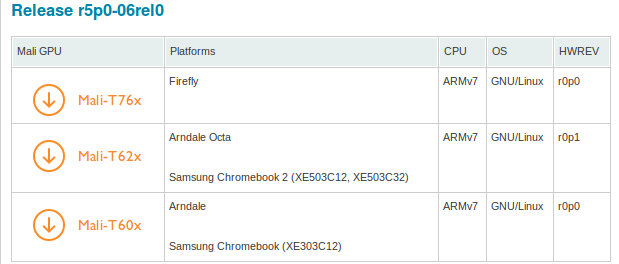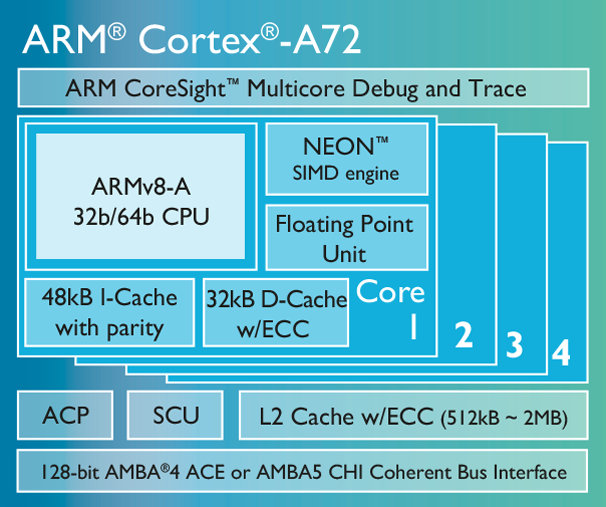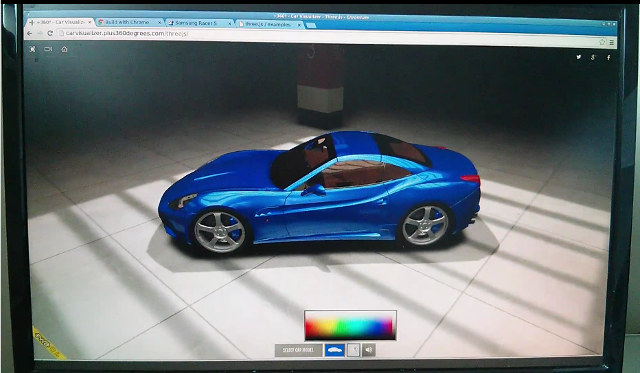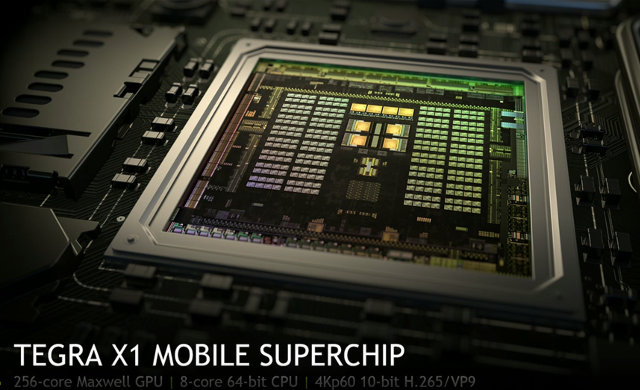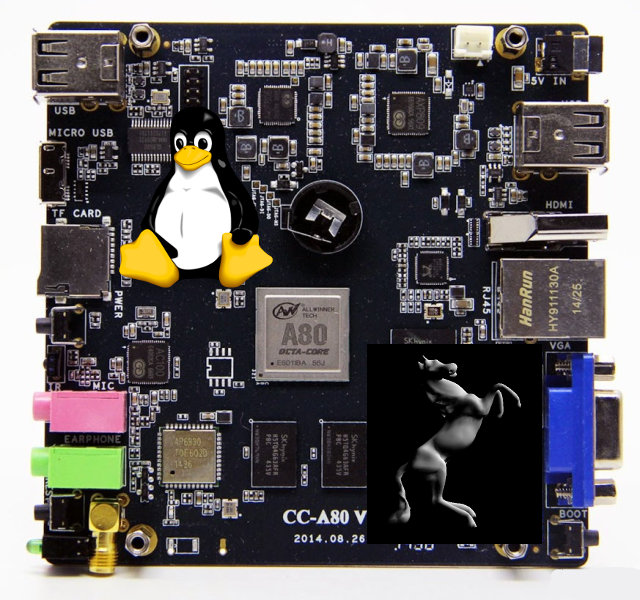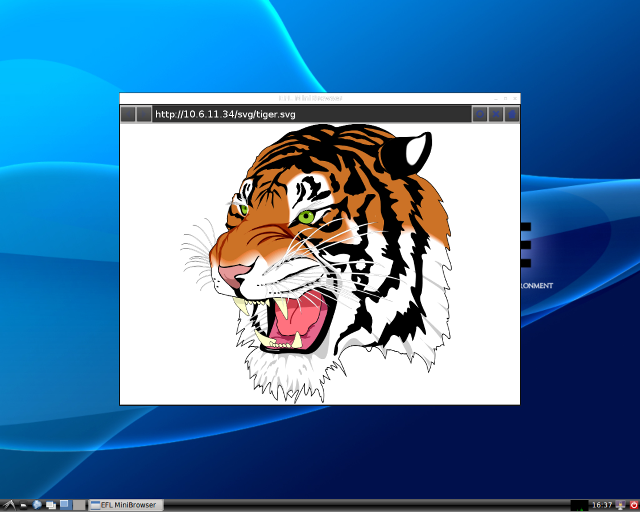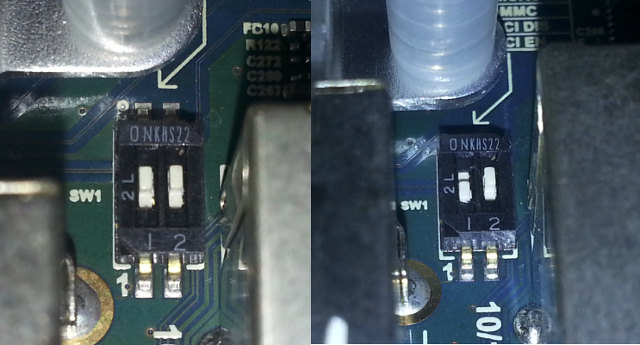ARM Mali GPU drivers includes both open source kernel drivers, and binary userspace drivers supporting framebuffer and/ior X11 implementation. The former is rarely an issue and is quickly released, but the latter requires porting and testing for a specific hardware platform, as well legal work, which greatly delay the releases. Mali-T880 GPU was announced at the beginning of the month together with ARM Cortex A72, and on February 17, 2015, ARM released an update to their Mali-T600 series, Mali-T700 series & Mali-T860/T880 GPU kernel device drivers with revision r5p1-00rel0 that adds supports to Mali-T860 and Mali-T880 GPU. These open source drivers are available for Android and Linux, and also support early Mali-T700 and T600 GPUs. Separately, the company has also released Mali-T76X GPU drivers for Firefly board powered by Rockchip RK3288 quad core Cortex A17 processor featuring a Mali-T764 GPU. The first release only supports the framebuffer driver, but ARM […]
ARM Unveils Cortex A72 Processor and Mali-T880 GPU
ARM has just announced their new Cortex A72 ARMv8 core with 3.5 times the performance of Cortex A15 ARMv7 cores, together with Mali-T880 GPU delivering 1.8 times the performance of Mali-T760, and CoreLink CCI-500 Cache Coherent Interconnect to link the new CPU, GPU and I/Os together. ARM Cortex A72 Some of the key features of the new core include: Architecture – ARMv8-A Multicore – 1-4x SMP within a single processor cluster, and multiple coherent SMP processor clusters through AMBA 5 CHI or AMBA 4 ACE technology ISA Support AArch32 for full backward compatibility with ARMv7 AArch64 for 64-bit support and new architectural features TrustZone security technology NEON Advanced SIMD DSP & SIMD extensions VFPv4 Floating point Hardware virtualization support Cache – 48KB I-cache, 32KB D-cache, and 512 KB to 2MB L2 cache with ECC Debug & Trace – CoreSight DK-A57 Process – 16nm FinFET A cluster can support up to […]
FOSDEM 2015 Schedule – January 31 – February 1 2015
FOSDEM (Free and Open Source Software Developers’ European Meeting) takes place every year during the first week-end of February. This year the developer-oriented event expects to bring over 5000 geeks to share ideas and collaborate on open source projects. Contrary to most other events, it’s free to attend, and you don’t even need to register, just show up. FOSDEM 2015 will take place on January 31- February 1 in Brussels. There will be 551 sessions divided into 5 keynotes, 40 lightning talks, 6 certification exams, and with the bulk being developer rooms and main tracks, divided into 7 main tracks this year: Languages, Performance, Time, Typesetting, Hardware, Security and Miscellaneous. I’m not going to attend, but it’s still interested to see what will be talked about, and I’ve concocted my own little virtual program out of the main tracks and developers’ rooms. There’s a few minutes overlap between some talks […]
Linux 3D GPU Acceleration Demo on Rockchip RK3288 based Firefly Board
Several devices and development boards based on Rockchip RK3288 processor already support Linux, usually with images based on Ubuntu, including Ugoos UM3 / UT3, Open Hour Chameleon, and Firefly-RK3288 among others. What these images lack however, is support for 2D and 3D graphics acceleration with the GPU, and hardware video decoding/encoding with the VPU. But Jas-hacks has made some progress with 3D graphics support. He has managed to add GPU acceleration via EGL/OpenGL ES bringing 3D acceleration to the platform, but 2D support is not there yet, meaning X11 still heavily relies on software rendering. But the implementation is still good enough to run the usual es2gears and glmark2-es2 benchmarks. as well as some WebGL demos in Chromium. Performance is currently underwhelming, with 50 points in glmark-es2, even a bit lower than the score (54 points) I got with ODROID-X board powered by Exynos 4412 SoC with a Mali-400MP4 GPU, […]
Nvidia Announces Tegra X1 64-bit Octa-core Processor with 256-Core Maxwell GPU
CES 2015 has started, and the first company to present their innovations is Nvidia. Last year their introduced Tegra K1, the first mobile processor with a desktop GPU with support for OpenGL. They’ve now raised the bar with Tegra X1, an octa-core 64-bit ARM processor with a 256-core Maxwell GPU delivering 1.5x to 2x the performance of Tegra K1, and supporting 4K60 video playaback with H.265 and VP9 codecs. Some geekbench benchmark comparing X1, K1, and Apple A8x. Nvidia CEO also claiemd Tegra X1 is the first mobie SoC delivering over 1 Teraflops, something that was achieved around year 2,000 with 20,000 Pentium pro processor consuming 1 millions Watts, while X1 SoC only consumes about 10 Watts. Power efficiency is said to have improved too, as Maxwell GPU is said to delivers more performance with similar power efficiency. They also introduced Drive CX mini computer for automotive application featuring Tegra […]
3D Graphics Acceleration in Linux on Allwinner A80 based Cubieboard4
Allwinner A80 is a powerful octa-core processor found in development boards and TV boxes such as Cubieboard4 or Tronsmart Draco AW80. Some early Ubuntu images and instructions had already been released for A80 Optimusboard and Draco AW80, but none of these featured GPU drivers for 3D acceleration, which to be honest, has limited advantages in Linux desktop distributions since desktop environments and most apps require full OpenGL support, i.e. not only OpenGL ES, and the only ARM SoC that can provide OpenGL support without external graphics card is Nvidia Tegra K1 SoC. Having said that GPU drivers would pave the way for smooth OpenELEC / Kodi user interface support in Allwinner A80 Linux distributions. That’s only one part of the puzzle, since the GPU normally handles the user interface, while the VPU takes care of video decoding. The good news is that CubieTech release updates images for their Cubieboard4 (CC-A80) […]
TyGL OpenGL ES 2.0 Backend for WebKit Speeds Up Web Rendering by Up to 11 Times
ARM, Szeged University in Hungary, and Samsung Research UK have been working on TyGL, a new backend for WebKit accelerated with OpenGL ES2.0, and developed and tested on ARM Mali-T628 GPU found in Samsung ARM Chromebook. It will typically provide 1.5 to 4.5 times higher performance, but in the best cases, it can achieve up to eleven times the performance of a CPU-only rendered page. The key features of TyGL include: Web rendering accelerated by GPU – Batching of draw calls delivers better results on GPUs. TyGL groups commands together to avoid frequent state changes while calling the Graphics Context API. Automatic shader generation – TyGL generates complex shaders from multiple shader fragments, and ensures the batches fit into the shader cache of the GPU. Trapezoid based path rendering – Work in progress. It will leverage GPU capabilities such as the Pixel Local Storage extension for OpenGL ES. No software […]
ODROID-XU3 Lite Board Ubuntu Review – Setup, Usability, and Performance
After testing ODROID-XU3 Lite with Android 4.4, and finding a workaround to some HDMI issues, I could finally try out Ubuntu, or rather Lubuntu with LXDE instead of Unity, in Hardkernel low cost octa-core development board. I’ll start this review by explaining how to install and setup Lubuntu on the board, followed by running various program to test the system usability as a desktop computer with LibreOffice, Chromium, XBMC, and 3D graphics, and finally run some performance tests with Phoronix Test Suit, build the Linux kernel natively, and transcode a video with avconf. Setting Up Ubuntu on ODROID-XU3 Lite All firmware images for ODROID development boards, can be found on odroid.in website, and if you want Ubuntu 14.04 image, go to ubuntu_14.04lts folder, to select the latest firmware file for your board. The latest image for ODROID-XU3 (Lite) is currently ubuntu-14.04.1lts-lubuntu-odroid-xu3-20141105.img.xz, it’s the same for micro SD card or eMMC […]


